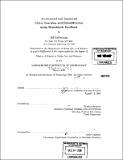Accelerated and improved motor learning and rehabilitation using kinesthetic feedback
Author(s)
Lieberman, Jeff I. (Jeff Ian), 1978-
DownloadFull printable version (5.859Mb)
Other Contributors
Massachusetts Institute of Technology. Dept. of Architecture. Program In Media Arts and Sciences
Advisor
Cynthia Breazeal.
Terms of use
Metadata
Show full item recordAbstract
About 21 million people in the United States [roughly 8%] have a basic motor skill inability [13], many stemming not from atrophy, but an improper mapping from the brain to the motor system. Devices exist today to aid people in rebuilding their motor system mappings, but do so in bulky, and inconvenient ways, since many of the users have adequate muscle strength, but the inability to control it properly. Hundreds of millions of people in the world participate in the arts, most of which involve motion of some sort. Typically, to become able to properly perform/paint/dance/etc, training is necessary. We learn from visual and auditory feedback, and sometimes, from the touch of a teacher. This research aims to improve the efficacy of such training with robotic touch, to enable people to become better, faster. This research proposes an augmented sensory feedback system - a lightweight comfortable wearable device that utilizes the communication channel of direct touch on the body, to give real-time feedback to the wearer about their performance in motor skill tasks. Using vibrotactile signals to indicate joint error in a user's motion, we enable a user to wear a full-body suit that provides subtle cues for the brain, as they perform a variety of motor skill tasks. (cont.) The hope is that utilizing tactile real-time feedback will act as a dance teacher or physical therapist does: by giving muscle aid through informational touch cues, not only through force or torque. This will enable people to undergo constant therapy/training, over all joints of the body simultaneously. with higher accuracy than a therapist/teacher provides. The device will enable more rapid motor rehabilitation and postural retraining to combat repetitive strain injuries (RSIs). It will also allow allow communication between a motion expert and a student in real-time [by comparing the student's performance to an expert's]. to aid in higher level motor learning skills such as sports and dance. It will function as a tool to accelerate and deepen peoples motor learning capabilities. This thesis focuses on actuator selection and feedback mechanisms for such a suit, in a low-joint-number test, comprising elements of the upper arm. Initial tests on a 5 degree-of-freedom suit show a decrease in motion errors of roughly 21% (p = 0.015), with 15% lower steady-state error (p = 0.007) and a 7% accelerated rate of learning (p = 0.007).
Description
Thesis (S.M.)--Massachusetts Institute of Technology, School of Architecture and Planning, Program in Media Arts and Sciences, 2006. Includes bibliographical references (p. 69-71).
Date issued
2006Department
Program in Media Arts and Sciences (Massachusetts Institute of Technology)Publisher
Massachusetts Institute of Technology
Keywords
Architecture. Program In Media Arts and Sciences